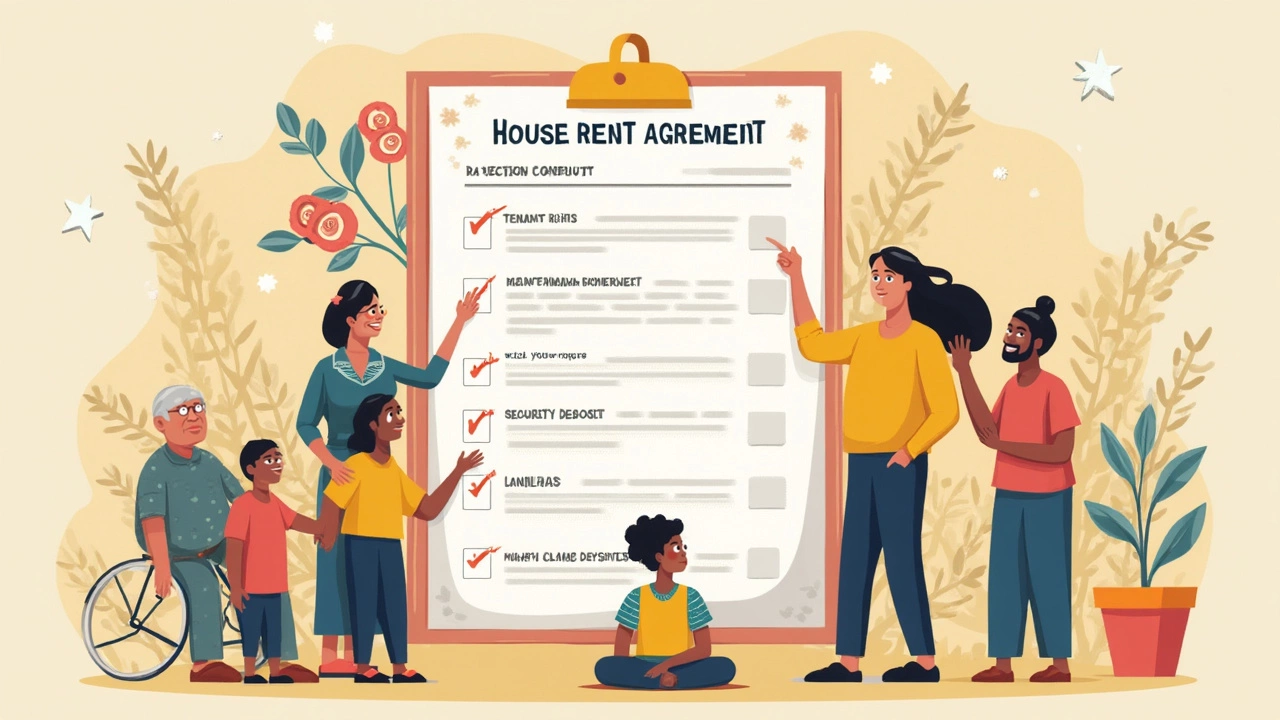If you've ever looked at those standard house rent agreement templates floating around, you know they can be long-winded and stuffed with confusing words. It makes you wonder if you really have to hire a lawyer or use a fancy online service just to put a roof over someone’s head. Good news—you can actually write your own rent agreement, and a lot of people do exactly that.
The law doesn't say you must use a specific format, as long as you cover the essential points and both sides agree. Sure, there are a few rules, like stamp duty, signatures, and local registration, but you don't need an expert for the basics. Landlords, tenants, and even family members renting a place to each other make their own agreements all the time—usually to save money, avoid delays, and keep things simple. My neighbor did one last year with his cousin. They wrote out the key points on A4 sheets, printed, and signed them at the coffee table—no drama, no hassle.
You just have to be smart about what you put down in writing. That means spelling out rent, duration, security deposit, who fixes the broken tap, and what happens if someone wants out early. If you skip important stuff or use confusing wording, you might run into problems if things get ugly later. But if you cover your bases, your homemade agreement holds real weight in court (assuming it's stamped and registered if required). Ready to figure out what details you can’t afford to miss?
- Why Consider Writing Your Own Agreement?
- The Essential Ingredients
- Common Mistakes People Make
- Taking It Up A Notch: Extras and Custom Rules
- Staying Legal: Registration and Stamps
Why Consider Writing Your Own Agreement?
There’s a common myth that you have to pay a lawyer or find an official template online to make a legit house rent agreement. Actually, Indian law lets you draft your own as long as both sides agree and the contract covers basic legal rules. The biggest reason people write their own? It saves money. Hiring a lawyer for even a simple rental contract can cost anywhere from Rs. 2000 to Rs. 10,000, while DIY agreements basically cost you the printing and stamp paper fees.
Another advantage: You get to include exactly what matters for your situation. Maybe you want to allow pets, set rules for guests, or add a weird clause (like the tenant can use your garden, but not the swing set). Cookie-cutter formats just don’t cover all those personal details, and they waste space on things you might not care about. Writing your own means you control the rules.
Speed is also a big win. I’ve seen landlords and tenants call up WhatsApp, swap ideas, and have a draft ready in an evening. If one side wants to make a change, there’s no waiting days for a third party to rewrite things. When my friend rented out his flat during the second wave of COVID, he needed an agreement for the tenant to move in quickly. He pulled up an online checklist, tweaked a few clauses in Word, and printed it that same night. No more chasing lawyers who take ages to respond.
And here’s something landlords don’t always tell you: most diy rental contract or “homemade” agreements hold up fine with police, banks, gas connections, and even in disputes, as long as registration and stamp duty rules are followed. That’s huge if you want to avoid extra legal drama.
India’s rental scene is changing too. According to a 2023 survey by NoBroker, nearly 56% of new rental agreements in major cities like Bangalore, Pune, and Hyderabad were drafted without hiring a lawyer. This isn’t just about saving money—people want control and speed, especially with five-minute e-registration in cities like Pune, Mumbai, and Thane.
| Lawyer Fees (per agreement) | DIY Agreement Cost | Time to Draft |
|---|---|---|
| Rs. 2000-10,000 | Rs. 200-600 (stamp & print only) | Same day or faster |
So, writing your own legal rental agreement isn’t just doable—it’s often the smarter choice these days, as long as you pay attention to the must-have details. Ready to see what absolutely needs to go in your DIY contract?
The Essential Ingredients
Writing your own house rent agreement can actually be pretty straightforward—if you know what details matter most. There’s a short list of stuff every rental contract really needs. Miss any of these, and you might be looking at trouble down the road, whether it’s about rent hikes, repairs, or getting your deposit back. Here’s what every legal rental agreement should clearly mention:
- Names and addresses – Don’t just put "landlord" and "tenant"; use actual legal names and contact details. This keeps things clear.
- Description of the property – Include the full address and, if possible, some kind of identifier like an apartment number. Attach a small layout map if the space is tricky to define.
- Rent amount and payment cycle – State exactly how much the rent is, the due date each month, and how the money should change hands (cash, transfer, UPI, etc.).
- Security deposit – Write down how much, where it’s kept, and the rules for getting it back when the tenant leaves.
- Duration – Fixed lease or month-to-month? Spell out the start and end dates or renewal terms.
- Notice period – How long before someone moves out do they need to tell the other side? Many folks use 1-3 months.
- Maintenance and repairs – Who handles what? Typically, small repairs go to the tenant; big stuff is the landlord’s job. Make it clear.
- Utilities and bills – Mention if things like water, electricity, and internet are included or need to be paid separately by the tenant.
- Signature lines – End the agreement with space for both parties to sign, along with witness signatures if possible. This isn’t just busywork—it’s crucial if things ever turn legal.
Adding these ingredients puts you way ahead of people who scribble a quick note and hope for the best. A survey from a property management company in 2024 found that 8 out of 10 disputes over rented homes came down to missing or vague terms about repairs, security deposits, or notice periods.
| Clause | What It Should State |
|---|---|
| Rent Amount | Rs. XXXXX per month, due by 5th of each month |
| Deposit | Amount, return conditions, deduction terms |
| Repairs | Tenant handles minor; landlord handles major work |
| Notice Period | 30 or 60 days written notice |
Don’t forget to date the agreement and attach copies of ID proof for both sides if possible. It saves headaches in case anything gets questioned later. These aren’t just details—they’re the heart of any diy rental contract.

Common Mistakes People Make
Trying to write your own house rent agreement can save money, but some classic goof-ups land people in trouble. Here’s what trips most folks up:
- Missing Key Details: Leaving out things like the exact rent amount, payment due date, or how much security deposit is paid can cause big fights. Also, many forget to write who does repairs (landlord or tenant) or who pays which utility bills. Leave these blank and you open the door to endless blame games.
- No Signatures Everywhere: Both the landlord and tenant need to sign every single page, not just the main page. Courts sometimes toss out agreements with missing or partial signatures.
- Forgetting Witnesses: In most states, you need two witnesses for a legal rental agreement to hold up, especially for longer leases. Neighbors or friends work fine—just don’t skip this step.
- Vague Duration or Exit Rules: Some people only write the start date, skipping an end date or how either side can end the deal. You always need a clear rental period and what happens if someone needs to break it early (eg: how much notice to give).
- Ignoring Stamp Duty and Registration: In India, rent agreements over 11 months must be registered, and even short ones need proper stamp paper. Skipping this makes the contract much weaker if a fight goes to court.
Check out this quick reality check on what often gets missed in DIY rent agreements:
| Common Omission | Potential Mess |
|---|---|
| No maintenance responsibility defined | Arguments when the sink leaks or walls need painting |
| Security deposit refund rules unclear | Endless calls & lost friendships over money |
| No end-of-term cleaning | Tenants leave a mess, landlords lose time cleaning up |
| No pet policy | Sudden surprises when furry (or scaly) roommates show up |
Simple fixes matter. It takes five minutes to add a pet clause, or clarify if tenants can put nails in the wall for their TV. My friend’s agreement didn’t cover visitors—her tenant tried hosting six people at once. Be specific and cover the weird but possible situations. When writing your own diy rental contract, triple check the little details. It’s way easier than dealing with fights or calls from lawyers later.
Taking It Up A Notch: Extras and Custom Rules
Sticking to the basics in a house rent agreement is good for starters, but real problems usually pop up in those extra day-to-day issues no one expects. That’s where custom rules save the day. The cool thing about writing your own rental contract is you can add literally anything—within reason—that both sides agree to.
For example, do you want to set quiet hours for the apartment? Add it in. Don’t want pets, or maybe you want to allow them but only if the place gets deep-cleaned at the end? Spell it out. My own lease at one point had a "cat-friendly" clause, mostly thanks to Leo (who, by the way, refuses to follow any human house rules). I included a note about minor pet-related damages and how we’d sort out repairs or cleaning from the deposit. You never realize how handy that is till your sofa gets a new set of scratch marks.
Here are some custom extras a lot of folks forget:
- Clear maintenance rules—who fixes the AC if it gives up in summer? The legal rental agreement should lay that out.
- Limits on the number of people living in the flat.
- Visitor restrictions (for avoiding late-night parties that annoy the neighbors).
- Parking slots or storage spaces—who gets what, and what counts as "common"?
- Rules about changing the paint or putting nails in the wall.
- Notice period for sudden repairs or scheduled visits by the landlord.
It helps to sit down together and brainstorm what could go wrong. Stuff like late rent penalties, rules around subletting, or whether you want to ban commercial use of the home—these are all up for grabs in your diy rental contract.
According to the 2022 All India Renting Survey, over 40% of urban tenants faced disputes about things not covered in their original agreement—mostly about repairs, extra people, and pets.
| Issue | % of Disputes |
|---|---|
| Repairs | 35% |
| Extra People/Guests | 28% |
| Pets | 19% |
| Others | 18% |
The main takeaway: If you can imagine the scenario, put it in the agreement. Both parties should read the document, talk through each line, and initial the odd rule if needed. A little extra time up front is way better than fighting over what counts as "normal wear and tear" when you’re ready to move out or want your deposit back.

Staying Legal: Registration and Stamps
This is where a lot of people mess up with their house rent agreement. Just writing stuff down and signing isn’t always enough. If you want that piece of paper to actually stand up if things get messy, there are rules about stamping and registration that you can’t ignore.
If your house rent agreement is for less than 12 months, you’re not legally required to register it in most states in India. But you still need to pay stamp duty. If it’s for a year or longer, you have to get the agreement registered at your local sub-registrar office. It may sound like a pain, but skipping this step is risky. Courts might reject unregistered agreements in case of a dispute, meaning rent recovery or eviction could turn into a total nightmare.
Here’s what typically needs to happen:
- Buy the correct value of stamp paper based on your state’s rules and the rent amount. Some states let you pay this online.
- Print or write out the agreement on this stamp paper.
- If the agreement is one year or longer (or renewing for a year+), head to the sub-registrar office with the landlord, tenant, and two witnesses to get it registered. Bring original documents and ID proofs.
- Pay the registration fee. This isn’t usually a huge amount—think a few thousand rupees.
- Keep the registered agreement safe—a scanned copy on your email isn’t a bad idea either.
To give you an idea of what the costs look like, here’s a quick example table (these can change, so always check your local rules):
| State | Stamp Duty (12-month rent + deposit) | Registration Fee |
|---|---|---|
| Maharashtra | 0.25% of total rent + deposit | Rs 1,000 |
| Karnataka | 1% of annual rent | Rs 500 |
| Tamil Nadu | 1% of total rent + deposit | Rs 1,000 |
Skipping stamping or registration isn’t just a technical goof; it can come back to bite you. If you ever have to prove your contract in court, an unregistered agreement is weaker in the eyes of the law.
If you want your rental deal to be “iron-clad,” don’t skip registration. As lawyer N.R. Srinivasan told The Hindu, “The registration process is not just a formality—it’s your protection against all kinds of disputes.”
The bottom line: always stamp and register your legal rental agreement if it’s for a year or more. Don’t let laziness or penny-pinching wreck your investment or housing peace.






